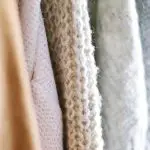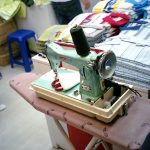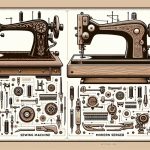Wondering whether using heavy thread is truly essential for your sewing projects? In 'Is Heavy Thread Really Necessary for Sewing? A Fabric Expert's Guide,' you'll uncover the ins and outs of thread weight and its impact on fabric performance.
This comprehensive guide delves into stitch quality considerations, sewing machine compatibility, and expert tips for selecting the right thread. Whether you're aiming for professional finishing techniques or tackling specialty fabrics, this resource is your key to mastering the art of thread selection.
Say goodbye to troubleshooting thread issues with the insights and strategies provided by a fabric expert. Get ready to elevate your sewing game and achieve flawless results with the right thread knowledge at your fingertips.
Key Takeaways
- Thread weight impacts the overall look and durability of stitches
- Heavy thread affects the durability, strength, and stretch of the fabric
- Proper thread tension ensures balanced stitches without puckering or stretching
- Consider fabric weight and composition when choosing needles
Understanding Thread Weight
When choosing thread for your sewing projects, understanding thread weight is crucial for achieving the best results. Thread weight impacts the overall look and durability of your stitches, as well as the performance of your sewing machine. The weight of the thread refers to its thickness, and it plays a significant role in the outcome of your sewing techniques.
Different thread weights are suitable for different sewing projects. For instance, heavier threads like topstitching or upholstery threads are ideal for sewing thick fabrics or for creating prominent topstitching details. On the other hand, lighter weight threads work well for delicate fabrics and intricate stitching.
The impact of thread weight on your sewing techniques is profound. Using the appropriate thread weight can make your stitches more even and balanced, providing a professional finish to your sewing projects. Additionally, it can prevent thread breakage and minimize tension issues on your sewing machine.
Understanding the relationship between thread weight and sewing techniques empowers you to make informed decisions when selecting the right thread for your projects, ultimately elevating the quality of your craftsmanship.
Impact on Fabric Performance
When sewing with heavy thread, you may notice an impact on the overall performance of the fabric. The durability of the stitching, the strength and stretch of the fabric, as well as the appearance and quality of the stitches are all factors affected by the weight of the thread used.
Understanding the impact of heavy thread on fabric performance is essential for achieving the desired results in your sewing projects.
Heavy Thread Durability
You will find that heavy thread durability significantly impacts the performance of the fabric. When using heavy thread, it's crucial to consider its strength and the necessary thread tension adjustments. The durability of heavy thread can make a substantial difference in the overall quality and longevity of the sewing project. Below is a table illustrating the impact of heavy thread durability on fabric performance:
| Heavy Thread Durability | Impact on Fabric Performance |
|---|---|
| High | Enhanced durability and strength |
| Medium | Moderate improvement in fabric performance |
| Low | Decreased fabric performance and durability |
Understanding the relationship between heavy thread durability and fabric performance can help you make informed decisions when choosing the right thread for your sewing projects.
Fabric Strength and Stretch
Maintain fabric integrity and elasticity by considering the impact of fabric strength and stretch on overall performance when selecting thread for your sewing projects.
Fabric strength refers to the ability of the material to withstand stress and tension without tearing or breaking, while fabric stretch pertains to its capacity to elongate and recover without losing shape.
When choosing thread, it's crucial to consider these fabric characteristics. A thread that's too strong for the fabric could cause it to pucker or gather, especially in areas with high fabric elasticity.
On the other hand, if the thread is too weak, it may not provide enough support, leading to fabric distortion. Achieving the right balance in thread tension is essential for preserving fabric elasticity and ensuring optimal performance in your sewing projects.
Stitch Appearance and Quality
Wondering how stitch appearance and quality impact fabric performance?
The thread tension and stitch tension play crucial roles in determining the overall quality of your sewing. Proper thread tension ensures that the stitches are balanced and don't pucker or stretch the fabric. When the tension is too tight, it can cause the fabric to pucker, while too loose tension may result in loopy or uneven stitches. These issues can compromise the fabric's integrity and affect its performance.
Additionally, stitch tension affects the overall appearance of the garment, impacting its drape and fit. By maintaining the correct thread and stitch tension, you can enhance the fabric's performance and durability, ensuring that your sewing projects retain their quality and integrity.
Stitch Quality Considerations
When considering stitch quality for sewing with heavy thread, it's important to assess the tension and needle size to achieve the desired results. Proper thread tension is crucial for ensuring that the heavy thread is securely held in the fabric without causing puckering or loose stitches. Additionally, using the correct needle size for heavy thread prevents skipped stitches and breakage, resulting in a more professional finish.
To further enhance stitch quality when working with heavy thread, consider the following:
- Thread Tension:
- Adjust the tension settings on your sewing machine to accommodate the heavier thread. This will help prevent the thread from being pulled too tightly or too loosely, ensuring a balanced and even stitch formation.
- Stitch Length:
- Opt for a slightly longer stitch length when sewing with heavy thread. A longer stitch length can prevent the fabric from becoming too dense and stiff, while also reducing the likelihood of the thread breaking under the strain of tightly packed stitches.
Sewing Machine Compatibility
Ensure that your sewing machine can accommodate heavy thread by checking its compatibility with thicker threads and adjusting the tension and feed dogs accordingly. Not all sewing machines are designed to handle heavy threads, so it's crucial to verify this before starting your project.
Look for a sewing machine that's labeled as heavy-duty or suitable for heavy fabrics and threads. Additionally, examine the machine's manual to see if it specifically mentions compatibility with heavy threads.
Once you've confirmed compatibility, adjust the thread tension to accommodate the heavier thread. This may involve loosening the tension to prevent the thread from breaking or getting stuck. Additionally, consider adjusting the feed dogs to ensure proper feeding of the heavy thread through the machine.
By taking these steps, you can optimize your sewing machine for heavy thread usage, resulting in smoother stitching and improved overall performance.
Always remember to conduct regular maintenance on your sewing machine to keep it in optimal condition for handling heavy threads.
Thread Selection Tips
When selecting thread for sewing, it's important to consider the weight of the thread and its impact on the final outcome of your project.
Understanding the compatibility between the fabric and thread is also crucial for achieving the best results.
These thread selection tips will help you make informed choices for your sewing projects.
Thread Weight Impact
You should consider the fabric type and project requirements when selecting the appropriate thread weight for sewing. The thread weight selection can significantly impact your sewing technique. Here are some tips to help you make the right choice:
- Consider the Fabric Type:
- Delicate fabrics like silk and chiffon work best with lightweight threads to avoid causing damage to the fabric.
- Heavier fabrics such as denim and canvas require thicker threads to withstand the stress of the fabric.
- Project Requirements:
- For decorative stitching or topstitching, heavier threads can add texture and visual appeal to your project.
- When creating garments, using a thread weight that complements the fabric weight will ensure the durability and longevity of the finished piece.
Fabric-Thread Compatibility
Selecting the appropriate thread weight for sewing involves matching the thread to the fabric's characteristics to ensure optimal performance and durability. When considering fabric-thread compatibility, it's crucial to pay attention to thread tension. The thread should complement the fabric, offering enough strength without causing puckering or pulling.
For lighter fabrics like silk or chiffon, opt for finer threads to prevent damage to the delicate fibers. Conversely, heavier fabrics such as denim or canvas will benefit from thicker threads to withstand the material's weight and tension.
Additionally, sewing needle size plays a vital role in fabric-thread compatibility. Choose a needle size that corresponds to the thread weight and fabric type for seamless stitching.
Professional Finishing Techniques
To ensure a polished and professional look, always reinforce your seams with topstitching using heavy-duty thread. This step is essential in achieving durable and well-finished garments.
Here are some professional finishing techniques to elevate your sewing projects:
- Use of Seam Binding and Piping
Incorporating seam binding or piping along the edges of your seams not only strengthens the seam but also adds a decorative touch to your garment, showcasing your professional expertise.
- Incorporating Decorative Stitching
Utilize decorative stitching, such as satin stitches or decorative zigzag patterns, to add a visually appealing finish to your garments. This attention to detail demonstrates your commitment to achieving a high-quality result.
Handling Specialty Fabrics
When working with specialty fabrics, skillful handling and appropriate thread selection are crucial for achieving professional results.
Fabric care is essential when dealing with delicate or unique materials. Always follow the fabric care instructions provided by the manufacturer to ensure that the fabric maintains its integrity throughout the sewing process. Pre-washing, testing for colorfastness, and using gentle detergents are all important aspects of fabric care that can impact the final outcome of your project.
In addition to fabric care, using the right specialty needles is vital when working with unique fabrics. Specialty needles, such as ballpoint or stretch needles, are designed to work with specific fabric types, preventing snagging, runs, or damage to the material. When selecting needles, consider the weight and composition of the fabric to determine the most suitable option for your project. Using the appropriate needle can prevent puckering, skipped stitches, or other sewing issues that may arise when working with specialty fabrics.
Troubleshooting Thread Issues
Experiencing thread breakage? Troubleshooting thread issues can be frustrating, but with a few adjustments, you can get back to smooth sewing in no time.
Here are some tips to help you troubleshoot common thread problems:
- Thread Tension
- Check the tension settings on your sewing machine. Incorrect tension can cause thread breakage. Adjust the tension according to the thread and fabric you're using.
- Ensure that the thread is properly seated in the tension disks. Sometimes, the thread can slip out of place, leading to tension issues and breakage.
- Knotting Issues
- Examine the needle. A dull or bent needle can cause the thread to knot and break. Replace the needle regularly to prevent this problem.
- Clean the bobbin area. Dust and lint can accumulate in the bobbin case, leading to irregular tension and knotting. Regularly clean this area to avoid thread issues.
Frequently Asked Questions
Can Heavy Thread Be Used for Delicate Fabrics Like Silk or Chiffon?
You can use heavy thread for delicate fabrics like silk or chiffon, but consider the thread weight and fabric drape. Heavy thread may affect the drape of delicate fabrics, so test it beforehand.
How Does Thread Weight Affect the Drape of the Fabric?
When sewing, thread weight affects fabric drape. Heavy thread can alter the way fabric hangs, impacting the look and feel of the garment. Adjust sewing techniques for different fabrics; delicate ones like silk require extra care.
Are There Any Specific Sewing Machine Brands or Models That Work Best With Heavy Thread?
When it comes to heavy thread compatibility, Singer machines, Janome models, and Brother sewing machines are often recommended. They can handle heavier threads and provide the necessary tension for sewing with thicker materials.
What Are Some Professional Finishing Techniques Specifically Tailored for Heavy Thread Sewing?
To achieve professional finishing with heavy thread, adjust thread tension and stitch length to accommodate the thread's thickness. Use a larger needle size and check bobbin tension for a balanced stitch. These techniques ensure a polished result.
Are There Any Special Considerations for Using Heavy Thread When Sewing Stretch Fabrics?
When sewing stretch fabrics with heavy thread, adjust your thread tension to accommodate the thicker thread. It's essential to use the appropriate needle size for stretch fabrics to prevent skipped stitches and ensure optimal stitch formation.
- How Does Ring Spun Cotton Affect Garment Fit and Shape Retention? - August 13, 2024
- What Are the Challenges in Producing Ring Spun Cotton? - August 13, 2024
- Is Ring Spun Cotton Suitable for Plus-Size Clothing? - August 13, 2024







